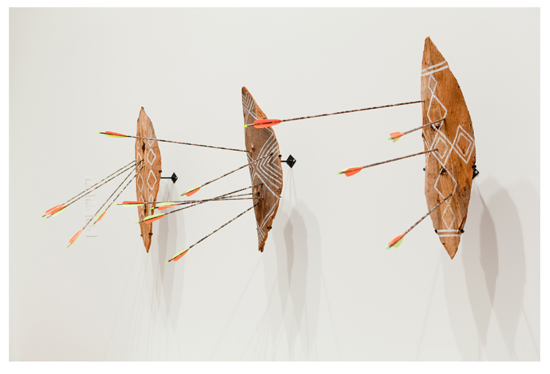From Stella Rosa McDonald…
For Primavera 2015 Heather Douglas, an artist from Titjikala on the Western edge of the Simpson Desert has repurposed panels of the water tank that served the cattle industry in her local area. Sections of tank hang in the gallery and Douglas, whose practice expands notions of printmaking, video and drawing to include organized graffitti, has facilitated collaborative works wherein each panel of the tank tells a story of the Titjikala community’s ancient relationship with water. Inscribed on each—in various materials including ochre, beeswax and sand—are water stories told by resident senior female artists from the community. The steel panels are rusted away in parts, some hang precipitously and sections of adjacent tanks are visible through the holes of others. More than oral histories rendered in colour, these are stories told by time. Inherent in Douglas’ work are the concerns of the other artists in Primavera, who ask questions of their inheritance, cultural and environmental responsibility and the personal conflict of identity.
The ageless practices of trade and warfare are used by these young artists as substitutes for mapping the personal and local facets of their contemporary life. Taloi Havini is part of the ‘blood generation’ from Arawa in the Autonomous Region of Bougainville, a generation defined by their birth during the deadly civil war that raged in Bougainville in the 1990s. Havini’s photographs of the Copper tailings of the Panguna mine, a ruined Australian colonial mine with its almost elegant rusted crane and electric-blue water streams, have a deadly beauty. The photographs appear lit from behind, giving them the effect of a museum display, an association that brings to mind the troubled history of ethnography and the collection and display of peoples and culture. Abdul Abdullah’s oil portraits further complicate notions of display representation as he riffs on the media’s portrayal of Australian Muslims. An ancillary catalogue essay by Richard Bell on Abdullah is illuminating and fits the tenor of an exhibition so tied to the weight of personal histories.
In another, yet distinct, evocation of warfare Steaphan Paton evokes the combat of recreational hunters and the military in his two-channel video installation Cloaked Combat #2 and #3 (2013) in which he appears in the Victorian bush armed with a crossbow and shoots arrows into a Gunai shield in an endless loop. Paton—whose work in Primavera includes handmade shields pieced by modern arrows—is interested in articulating the values of hybrid and fringe cultural practices. Through either material use or narrative allusion there is, in the work of the seven included artists, a repeated concern with their immediate environments and a sense that those personal ecosystems cumulatively hold the key to understanding ourselves. Complex and elaborate works by brothers Vincent and Vaughn O’Connor and Lucy Simpson round out a quiet and considered Primavera in which the artists expertly exaggerate parts of personal and collective memory, history and archeology so that it may be better understood. We hear their stories.
Until 6 December
Museum of Contemporary Art, The Rocks
Pic: Steaphan Paton, Cloaked Combat, 2013, bark, carbon fibre, synthetic polymer resin, synthetic polymer paint. National Gallery of Victoria, Melbourne, Yvonne Pettengell Bequest, 2013. Image courtesy the artist and Anna Pappas Gallery, Melbourne © the artist

